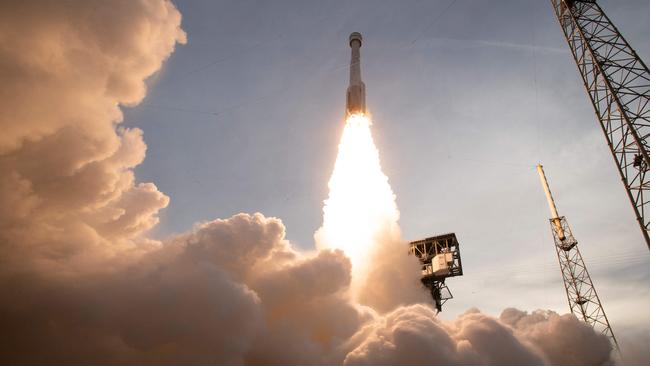Boeing’s Starliner launches for ISS
American aerospace giant Boeing’s Starliner capsule was heading for the International Space Station on Friday.

American aerospace giant Boeing’s Starliner capsule was heading for the International Space Station on Friday, in a critical uncrewed test flight that followed years of failures and false starts.
The spacecraft encountered some propulsion troubles early in its journey, with two thrusters responsible for orbital manoeuvring failing for unclear reasons – but NASA officials said the mission remained on track.
The Orbital Test Flight 2 mission blasted off at 6.54pm on Thursday (8.45am Friday AEST) from the Kennedy Space Centre in Florida, with the spaceship fixed atop a United Launch Alliance Atlas V rocket.
Its success is key to repairing Boeing’s frayed reputation after the first bid, in 2019, failed to dock with the ISS due to software bugs – one that led to it burning too much fuel to reach its destination, and another that could have destroyed the vehicle during re-entry.
A second try was scheduled last August, but Starliner was rolled back from the launch pad to address sticky valves that weren’t opening as they should, and the capsule was eventually sent back to the factory for fixes.
At a post-launch press conference, senior NASA official Steve Sitch said: “Overall, the spacecraft is doing really well,” but he also flagged two anomalies that engineers were now working to understand.
The first was that two out of 12 orbital manoeuvring and attitude control thrusters on Starliner’s aft side had initially fired but then shut down, forcing a third to take up their slack. The second issue was that a device known as a sublimator responsible for cooling the spacecraft was initially slow to get started.
NASA is looking to certify Starliner as a second “taxi” service for its astronauts to the space station – a role that Elon Musk’s SpaceX has provided since succeeding in a test mission for its Dragon capsule in 2020.
Both companies were awarded fixed-price contracts – $US4.2bn to Boeing, and $US2.6bn to SpaceX – in 2014, shortly after the end of the Space Shuttle program, during a time when the US was left reliant on Russian Soyuz rockets for rides to the orbital outpost.
Boeing, with its hundred-year history, was considered by many as the sure shot, while then-upstart SpaceX was less proven. In reality, it was SpaceX that rocketed ahead, and has just sent its fourth routine crew to the research platform – while Boeing’s development delays have cost the company hundreds of millions.
Starliner should dock with the ISS sometime Saturday morning AEST, and deliver more than 226kg of cargo, including food and provisions such as clothes and sleeping bags for the current crew on the station.
Its sole passenger is a mannequin named Rosie the Rocketeer – a play on the World War II campaign icon Rosie the Riveter – whose job is to collect flight data with her sensors in order to learn what human astronauts would experience. “We are a little jealous of Rosie,” said NASA astronaut Mike Fincke, who is expected to be among the first crew selected for a manned demonstration mission should OFT-2 succeed.
AFP



To join the conversation, please log in. Don't have an account? Register
Join the conversation, you are commenting as Logout